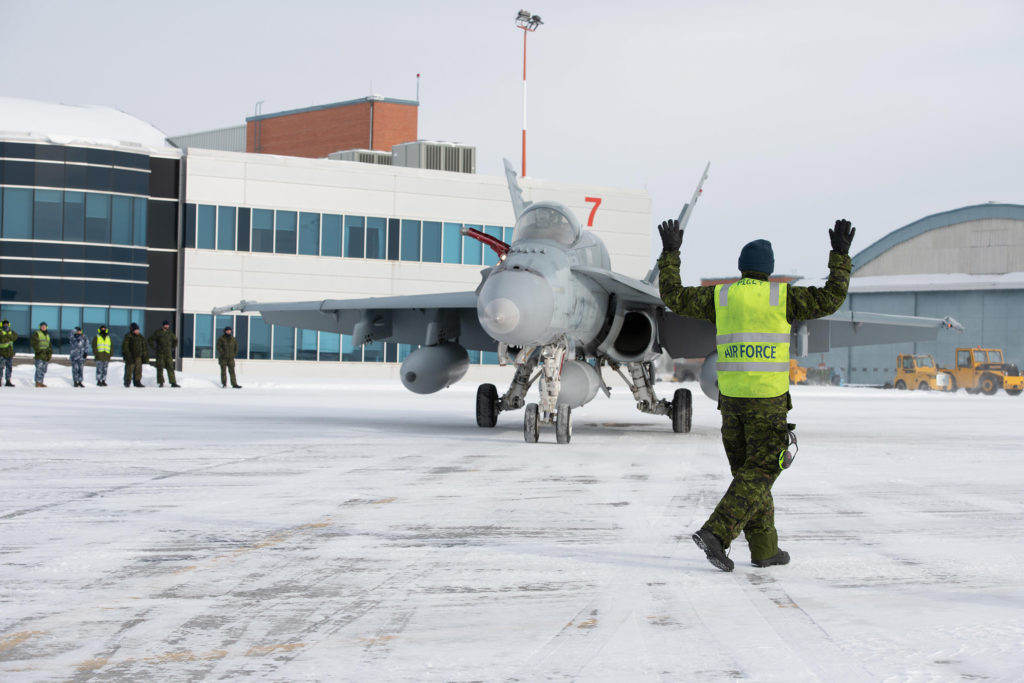Estimated reading time 6 minutes, 12 seconds.
On Feb. 16, the Royal Canadian Air Force (RCAF) accepted the first two of 25 Australian F/A-18A Hornet fighter aircraft at 4 Wing Cold Lake, Alta.

The federal government is acquiring the 30-year-old jets to fill a capability gap it claims is affecting the RCAF’s ability to simultaneously meet NORAD and NATO obligations. Eighteen of the jets will be brought up to operational standard while seven will be reserved for parts.
“The interim fighter fleet is key to ensuring the [RCAF] can continue to fulfil their missions and ensure the safety of Canadians and Canada,” said Defence Minister Harjit Sajjan in a statement.
The two aircraft were flown to Cold Lake from Nellis Air Force Base in Nevada, where they were participating in Exercise Red Flag.
Before the F-18s can be integrated into the Canadian fleet of CF-188 Hornets, they will undergo several modifications at L-3 MAS in Mirabel, Que., to bring them up to the same operational configuration as the Canadian CF-188 Hornets, including cockpit and communications upgrades, a night vision imaging system, a sniper targeting pod, landing gear modifications, a new ejection seat, and of course the Air Force paint scheme.
“We will make the necessary investments in these aircraft to ensure they meet the requirements of the [RCAF],” said Carla Qualtrough, Minister for Public Services and Procurement Canada in a statement.
As part of the reconfiguration, the Australian jets could also see an upgrade to their combat capability. A review by the Air Force is currently underway to assess any necessary improvements to the combat capability of the Canadian Hornet fleet after an Auditor General’s report in November flagged a shortage of pilots and the declining combat capability of the aircraft as the two “biggest obstacles to meeting the new operational requirement.” The review is expected to be completed by spring 2019.
The budget to acquire the Australian jets and extend the life of the current fleet of 76 Hornets until a new fighter is procured beginning in the mid 2020s is about $3 billion.
Deliveries of the Australian Hornets will continue at regular intervals for the next three years, with the final aircraft expected by the end of 2021. The jets will be distributed among the tactical fighter squadrons and operational training squadron at 3 Wing Bagotville, Que., and 4 Wing Cold Lake.

The Liberal government has been criticized for manufacturing the capability gap and unnecessarily acquiring an interim fleet. Patrick Finn, assistant deputy minister for materiel at the Department of National Defence, however, assured a Senate committee in late October that the Australian jets would help the Air Force transition to an eventual replacement fighter.
“These aircraft will really increase our fleet, and it is not the number of aircraft that counts; it is rather the hours of use in the future,” he explained. “We are looking for an aircraft that will remain in service for another 14 years. What is needed is enough hours on the structural side. We will be able to use these aircraft until the entire fleet is no longer in service.”
As the interim capability is introduced, the Air Force is also trying to address the other issue highlighted in the Auditor General’s report–a lack of experienced pilots and maintenance technicians.
MGen Alain Pelletier, chief of the fighter capability project, told an Ottawa conference on defence and security on Feb. 13 that several initiatives were being implemented to retain pilots and technicians.
“Given that there is a lot of pull out in the commercial marketplace for skilled technicians and pilots, we’re doing our best to retain our folks to actually deliver the capability that is expected of the RCAF,” he said.
It takes five to seven years to develop a fighter pilot and a frontline technician able to lead a crew at the squadron level, he noted. While new recruitment efforts will help bring more people into the Air Force, they won’t resolve the challenge of having enough experienced people at both the operational squadrons and in the training system.
Without those experienced people, delivering all the capability outlined in the government’s 2017 defence policy would be a challenge, he said. “We need the right people with the necessary skills on the squadrons to deliver.”
The problem isn’t unique to the RCAF. Commodore Steve Waddell, the Royal Canadian Navy’s director general for naval strategic readiness, observed that the military as a whole is competing with the commercial sector for much-needed talent. Most Navy trades, he said, are short about 10 per cent and can be as low as 60 per cent capacity when sailors are on leave, taking professional development courses or otherwise unavailable for active duty.
The Navy will make greater use of data, artificial intelligence and machine learning to help the workforce “to be more efficient” and reprofile its people to deliver the defence policy, he said.









Lov the Cf-18’s …awesome ..wish these Beauties still were flying out of Edmonton base instead of those putt putt Helicopters …ugh !!
IT IS NICE TO SEE THAT THE TAXPAYER IS PAYING TO BUY ANOTHER COUNTRIES WELL USED SOON TO BE WORN OUT AIRCRAFT. I AM SURE THE AUSSIES ARE LAUGHING THAT
THEY PAWNED OFF OLD PLANES TO THE CANADIANS. OH WELL IT IS ONLY THREE BILLION